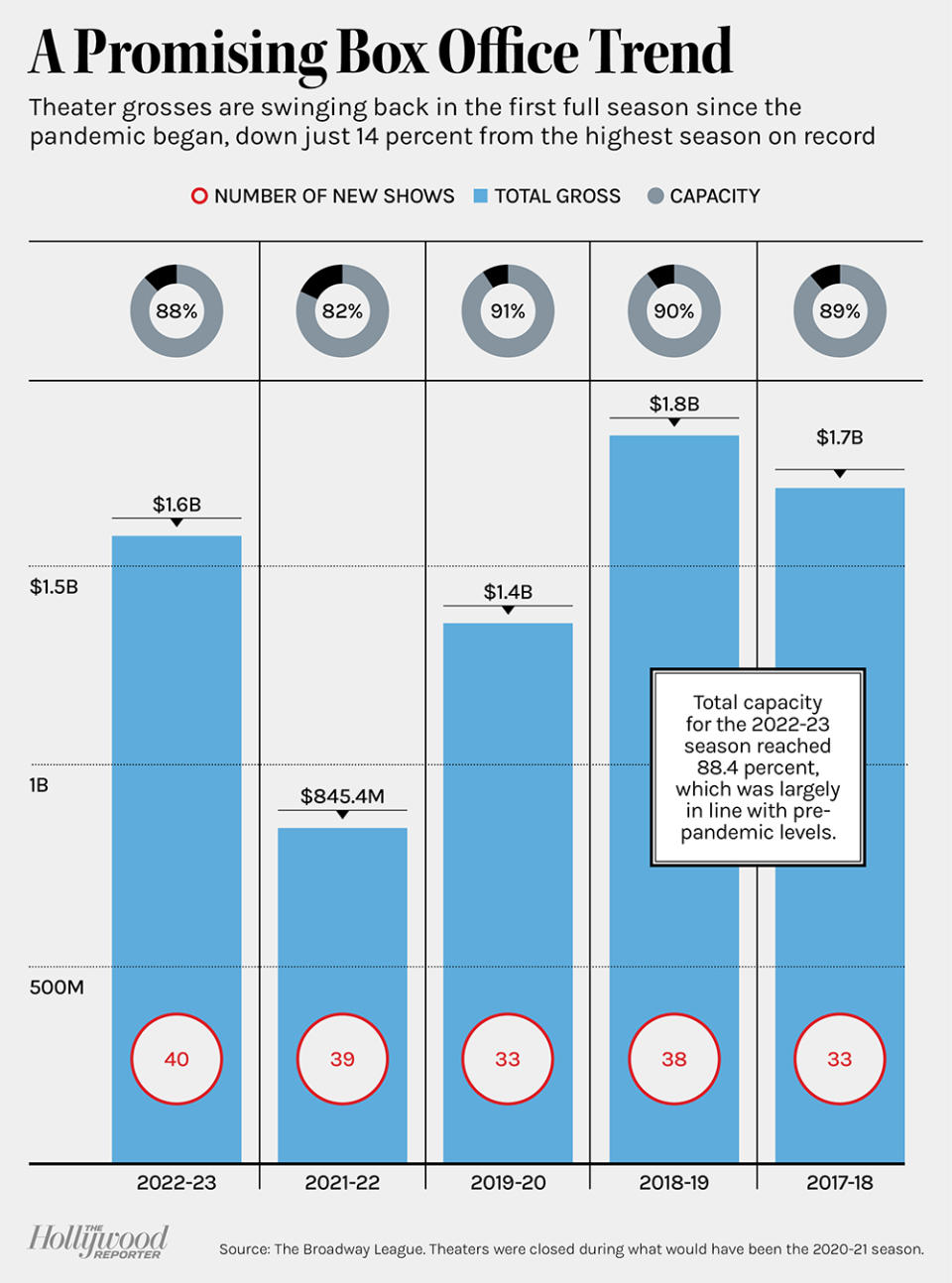Broadway Is Rebounding, Even Though “the Suburbs Have Not Come Back”

In the 2022-23 season — Broadway’s first full season since the pandemic began — the industry almost bounced back to pre-COVID levels.
The total gross for the season reached nearly $1.6 billion, which is a marked improvement from the previous two seasons but still below the pre-pandemic total of $1.8 billion in 2018-19, according to new data from the Broadway League. Attendance reached 12.3 million, above the previous two years’ totals but also below the 14.8 million in 2018-19, which was the highest-grossing and best attended season ever.
More from The Hollywood Reporter
Total capacity reached 88.4 percent, largely in line with pre-pandemic levels. This past season was the first without major disruptions from COVID-19 — in contrast to the 2021-22 season, which began later than the usual May opening, with the first show starting in August, followed by a staggered rollout of shows throughout the fall as the industry got back on its feet after all theaters had been closed. However, because of a surge in COVID-19 cases related to the omicron variant, many productions were forced to cancel performances or close prematurely in December and January. Sixteen of the season’s 42 weeks saw performance cancellations, and the season grossed just over $845 million, with attendance at 6.7 million.
The 2019-20 season was infamously cut short by the closure of all Broadway theaters on March 12, 2020, and grossed $1.4 billion, with attendance at 11.1 million. Theaters were still closed during what would have been the 2020-21 season.
The 2022-23 season saw the entrance of several high-grossing shows, such as the revival of Sweeney Todd, starring Josh Groban and Annaleigh Ashford, as well as the closure of The Phantom of the Opera, which brought in an eye-popping $3.7 million in its last week of performances after 35 years on Broadway. Other big earners have included such stalwarts as Hamilton and The Lion King, along with brands like MJ: The Musical. Original shows continue to lag, as many audience members gravitate toward known intellectual property rather than new material since the pandemic.
Grosses are down about 13 percent from the record 2018-19 season but down only 7 percent from the year before that. The remaining gap is largely caused by the reluctance of suburban audiences to return — related in part to the fact that many suburbanites have not returned to working in their city offices during the week — as well as a slower return of international visitors, particularly from China, per Mike Rafael, a ticketing sales consultant on Wicked and the new musical Kimberly Akimbo.
“Some of the international has come back, groups have come back,” Rafael says. “The suburbs have not come back. And that’s the big item for me.”
The numbers show “unbelievable progress” for the industry, considering how quickly it went from no income during the theatrical shutdown to $1.6 billion, says Ken Davenport, a producer on the Neil Diamond biomusical A Beautiful Noise, which opened this past season. He notes, though, that the cost of productions continues to increase thanks to inflation, which means that Broadway totals also need to rise. “We need to continue to grow the industry every year,” he says. “We’re an industry whose expenses increase dramatically every year, and especially over the last three.”
As a greater portion of the international audience returns, and audiences get back into the habit of going to the theater (with concerns about COVID-19 safety now largely gone), there’s belief that the industry will be able to make a full rebound next season. Says Davenport, “It will get better and better, and we’ll hit $2 billion soon enough.”

This story appears in the May 31 issue of The Hollywood Reporter magazine. Click here to subscribe.
Best of The Hollywood Reporter
Meet the World Builders: Hollywood's Top Physical Production Executives of 2023
Men in Blazers, Hollywood’s Favorite Soccer Podcast, Aims for a Global Empire

